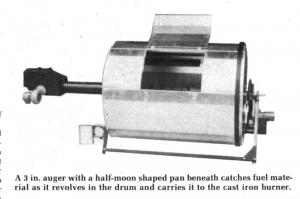1981 - Volume #5, Issue #5, Page #31
[ Sample Stories From This Issue | List of All Stories In This Issue | Print this story
| Read this issue]
Equip Your Furnace To Burn Corn Cobs?
 |
"I've heated my 1,600 sq. ft. home with it for the past four years with no cost other than electricity to power the small electric motor on the drum," says Messersmith, a heating contractor who's building the new burner in his Carney, Mich. shop. "At 10? below zero, this unit will heat for 28 hours so, at most, you'll only have to refuel once a day."
Messersmith's heater consists of a small cast iron "firebox" that fits inside your existing furnace and is connected to a 3 by 4-ft. stoker drum that's "the key to the entire system," according to Messersmith. It feeds a continuous flow of fuel to the burner unit in the furnace.
"A 3 1/2 in. auger runs lengthwise down the center of the drum. It has a half-moon shaped pan underneath that leaves the auger exposed on top. When the drum is filled with cobs or sawdust, the material is carried up and over by paddles on the revolving drum's sides so that it drops into the exposed auger, which carries it out of the drum." Messersmith explains.
The drum and auger are powered by a 1/20 hp motor that's thermostatically controlled. Messersmith says it runs only when the thermostat calls for heat, except in warmer weather when the timer causes it to run 15 seconds out of every half hour to keep "pilot coals" burning. When empty, he says it takes just a couple minutes to refill the drum from a storage hopper.
"There's very little or no smoke in-side the burner as it burns. I've had no need to clean my chimney in the past four years, even though I've burned tons of cobs and sawdust," says Messersmith. A small fan force feeds air into the burner grate so that, as sawdust feeds out of the drum, it actually burns in suspension.
Messersmith says the burner can be adapted to most older oil, wood and coal furnaces, even if they've been converted to gas or other fuels. If they have an ash door opening of 9 by 5 1/2 in. high or larger, it's just a matter of sticking the end of the burner unit into the burning chamber and turning it on. The unit won't install in most newer gas furnaces, however,unless the furnace has an unusually large burning chamber.
"Some of the units I've sold have gone on year-around boilers. One school, for example, installed one of my burners last year and burned less than $300 worth of fuel, compared to their fuel oil bill of $9,000 the year before. This burner could also be used to heat a barn or shop by placing the burner in a barrel or wood stove," Messersmith points out.
The one-size burner can be varied from 100,000 to 500,000 btu by speeding up or slowing down the speed of the drum. Any flammable material 1 in. sq. or smaller, such as corn cobs run through a chopper, can be used.
This fall Messersmith plans to try dry-chopped corn stalks. Depending on the material burned, he says ash only has to be cleaned from the burner every few days. "We got less than a trash can full of ash from a semi-load of sawdust last year," he says.
If you don't use corn cobs, sawdust is usually available for around $5 a ton, according to Messersmith. For burning in the home, he recommends setting up a hopper near the house that can be funneled to the unit. He says he plans to work on an automatic re-fueler in the future.
The unit sells for $1,500 and Messersmith says it's simple enough that, in most cases, you can install it yourself.
For more information, contact: FARM SHOW Followup, Messersmith Manufacturing, Rt. 1, Box 388, Carney, Mich. 49812 (ph 906 639-2605).

Click here to download page story appeared in.

Click here to read entire issue
To read the rest of this story, download this issue below or click here to register with your account number.




